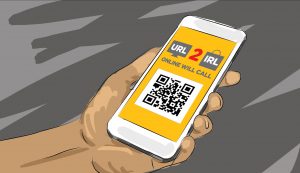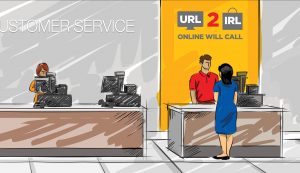My gut feeling about BOPIS (Buy Online, Pickup In Store) is that it is great for customers but not easy to execute for retailers. BOPIS is another omnichannel marketing process offering a frictionless purchase process for the consumer. Simply put, BOPIS puts the customer in control. This blog shows how this trend can challenge retailers and consumers as well as delight them.
Our Interpretation of BOPIS
We recently participated in a design challenge from “design:retail” magazine centered around BOPIS. Our concept was to have a confirmation sent to the customer’s phone with a QR code that can be scanned at the store which reinforces the program name URL 2 IRL (URL 2 In Real Life), and branding. It also provides day, time and pick up location. At the front entrance of the store there is a window cling that mentions the ONline Will call service and indicates the location for pickup. The bright colors and consistent visuals make it readily apparent to customers that they are going to the right area, which is near but separate from customer service. At this time, the sales rep will confirm that there are no other items needed. They should also be able to check the customer out without them having to wait in another line. To motivate the sales rep, they will get credit for the sale. Curbside service with a scanner is also offered that announces to the store that a customer is there for an online order pickup. The customer wouldn’t need to go into the store at all. This is especially helpful with oversized items.




Why retailers are challenged by BOPIS
There are many reasons why this concept is a challenge for retailers. Several of the ideas submitted to “design:retail” don’t have the customer come into the store at all. Yet retailers prefer when a customer comes in the store because customers often pick up a lot more than what they intended. Customers inevitably pick up some products that they weren’t intending on purchasing. With BOPIS, they shop for the exact items they want and can pick them up outside of the store.
Executing a great BOPIS experience isn’t without its issues. Here are a few:
- The retailer must have an accurate inventory count of all products.
- Since the transaction happens online, but is picked up in store without a card being present, this opens the store up to fraud.
- Since the buyer isn’t required to put in a delivery address, there is no way to verify the address with the credit card.
Why customers love BOPIS
This concept caters to the needs of the customer. Customers have time constraints and other limitations. The notion that they can just drive in and pick up what they need and leave without standing in a line or setting foot in the store is appealing. One of the concepts submitted for the design challenge referred to their idea as a retail outpost. They actually came to the customer with a mini store on wheels. Here are some of the main reasons customers love BOPIS
- No shipping charges
- No risk of having the package stolen from the porch
- Time saver
- Immediate gratification
When BOPIS might not work for the customer
Since the customer judges a retailer by the type of experience they have while shopping, the retailer is concerned with making their experience a positive one. However, the retailer can’t control all aspects of BOPIS. Listed below are some of the pitfalls:
- The wrong item was provided.
- The customer really needed additional items to use with what they purchased but weren’t aware.
- A sales person could have told the customer there was another item that suited their needs better.
- The customer realizes they have the wrong size, the wrong color, etc. after they get home
Bottom line for BOPIS
Some retailers have executed the BOPIS strategy better than others and soon it will become a common expectation for all retailers to have this option. The ability to buy on line and pick up in store is the ultimate merger of digital eCommerce and brick and mortar. One thing I would like to do is get rid of the acronym BOPIS and refer to it as “click and collect”.
The good and the bad news for BOPIS

Leave a Reply